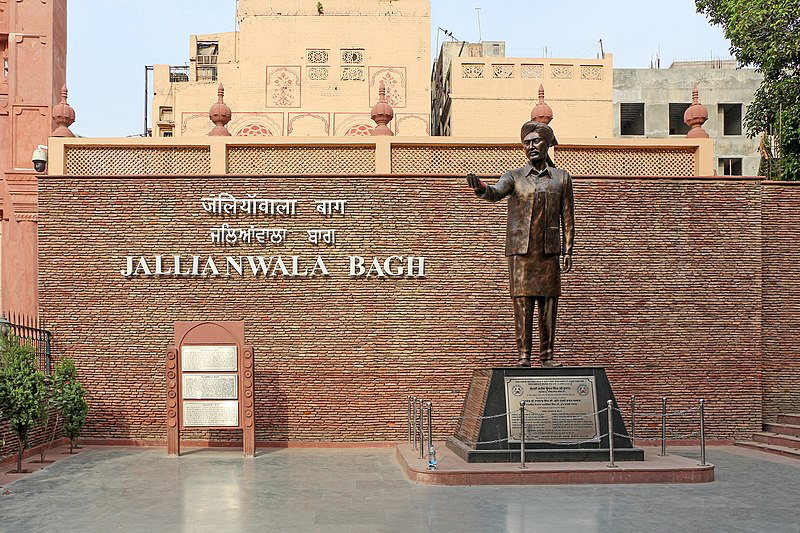Description

Disclaimer: Copyright infringement not intended.
Context
- On April 13, 1919, what was planned as a protest gathering of Indians in a compound called Jallianwala Bagh in Amritsar, Punjab, in the then British-ruled India, witnessed violence that would become one of the most lasting memories of the barbarity of colonial rule.
- Wartime British Prime Minister Winston Churchill went on to describe the day as “monstrous” and an inquiry was set up to probe Dyer’s orders.
Details
- The Jallianwala Bagh massacre marked a turning point in India’s struggle for Independence.
- A memorial was set up by the Government of India in 1951 at Jallianwala Bagh to commemorate the spirit of Indian revolutionaries and the people who lost their lives in the brutal massacre.
- In March 2019, the Yaad-e-Jallian Museum was inaugurated showcasing an authentic account of the massacre.
.jpeg)
Political Backdrop
- The massacre of April 1919 wasn't an isolated incident, rather an incident that happened with a multitude of factors working in the background.
- The Indian National Congress had assumed self-governance would be granted once WWI ended but the Imperial bureaucracy had other plans.
- The Rowlatt Act (Black Act) was passed on March 10, 1919, authorizing the government to imprison or confine, without a trial, any person associated with seditious activities. This led to nationwide unrest.
|
These Bills curtailed the civil liberties of Indians and let colonial forces arrest people without any warrant or trial. One of the Acts was pushed through the Legislative Council ignoring objections of elected Indian representatives, leading to resentment among Indians. Some violent protests had been witnessed in cities of Delhi, Bombay (now Mumbai) and Lahore as well, even as MK Gandhi called for the launch of a non-violent peaceful protest at the time.
|
- Gandhi initiated Satyagraha to protest against the Rowlatt Act.
- On April 7, 1919, Gandhi published an article called Satyagrahi, describing ways to oppose the Rowlatt Act.
- The British authorities discussed amongst themselves the actions to be taken against Gandhi and any other leaders who were participating in the Satyagraha.
- Orders were issued to prohibit Gandhi from entering Punjab and to arrest him if he disobeyed the orders.
- Sir Michael O’ Dwyer, the Lieutenant Governor of Punjab (1912-1919), suggested that Gandhi be deported to Burma but this was opposed by his fellow officials as they felt it might instigate the public.
- Dr Saifuddin Kitchlew and Dr Satyapal, the two prominent leaders who were a symbol of Hindu-Muslim unity, organised a peaceful protest against the Rowlatt Act in Amritsar.
- On April 9, 1919, Ram Naumi was being celebrated when O’ Dwyer issued orders to the Deputy Commissioner, Mr Irving to arrest Dr Satyapal and Dr Kitchlew.
- On April 10, 1919, the infuriated protestors marched to the Deputy Commissioner’s residence to demand the release of their two leaders. Here they were fired upon without any provocation. Many people were wounded and killed.
- One of the mishaps was the attack on Miss Sherwood, Superintendent of the Mission School in Amritsar.
April 13, 1919 - Jallianwala Bagh Massacre
- After passing the Rowlatt Act, the Punjab Government set out to suppress all opposition.
- On April 13, 1919, the public had gathered to celebrate Baisakhi. However, the British point of view indicates that it was a political gathering.
- Inspite of General Dyer’s orders prohibiting unlawful assembly, people gathered at Jallianwala Bagh, where two resolutions were to be discussed, one condemning the firing on April 10 and the other requesting the authorities to release their leaders.
- When the news reached him Brigadier-General Dyer, headed to the Bagh with his troops.
- He entered the Bagh, deployed his troops and ordered them to open fire without giving any warning.
- People rushed to the exits but Dyer directed his soldiers to fire at the exit.
- The firing continued for 10-15 minutes. 1650 rounds were fired. The firing ceased only after the ammunition had ran out.
- The total estimated figure of the dead as given by General Dyer and Mr Irving was 291. However, other reports including that of a committee headed by Madan Mohan Malviya put the figure of dead at over 500.

Post Jallianwala Bagh
- Two days after the massacre, Martial Law was clamped down on five districts - Lahore, Amritsar, Gujranwala, Gujarat and Lyallpore.
- The declaration of Martial Law was to empower the Viceroy to direct immediate trial by court-martial of any person involved in the revolutionary activities.
- As the news of the massacre spread across the nation, Tagore renounced his Knighthood
Hunter Commission
- On October 14, 1919, the Disorders Inquiry Committee was formed to inquire about the massacre. It later came to be known as the Hunter Commission.
- The Hunter Commission was directed to announce their verdict on the justifiability, or otherwise, of the steps taken by the government.
- All the British officials involved in the administration during the disturbances in Amritsar were interrogated including General Dyer and Mr Irving.
- General Dyer’s actions on the day of the Massacre received a prompt acknowledgement from Sir Michael O’ Dwyer who at once wired to him: "Your action correct. Lieutenant-Governor approves.”
- The Committee indicated the massacre as one of the darkest episodes of the British Administration.
- The Hunter Committee condemned the incident but did not impose any punishment on Dyer.
- Ultimately, the Commander-in-Chief of the Army directed Brig Gen Dyer to resign his appointment as Brigade Commander and informed him that he will receive no further employment in India.
- However, Dyer remained a divisive figure at the time. Imperialists at home lauded Dyer for his actions against what they termed as unrest in India.
- Conservative newspapers and organisations in the UK later arranged for a fund for Dyer and collected a significant amount.
- Dyer would go on to retire and live in Britain. Incidentally, Michael O’ Dwyer, the officer to order martial law, was later assassinated in 1940 in his retirement by Sardar Udham Singh, an Indian man who was present at Jallianwala Bagh and escaped the atrocities. Reports suggest that in his personal diary he frequently referred to O’Dwyer as Dyer, possibly because he confused the two.
O’ Dwyer’s Assassination
- On March 13 1940, at Caxton Hall in London, Udham Singh, an Indian freedom fighter, killed Michael O'Dwyer who had approved Dyer's action and was believed to have been the main planner.
- Gandhi negated Udham Singh’s action and referred to it as an "act of insanity". He also said, “we have no desire for revenge. We want to change the system which produced Dyer.”
|
PRACTICE QUESTION
Q) The Jallianwala Bagh massacre marked a turning point in India’s struggle for Independence. Comment. (150 words)
|

https://indianexpress.com/article/explained/explained-history/jallianwala-bagh-anniversary-what-happened-to-general-dyer-8554153/















